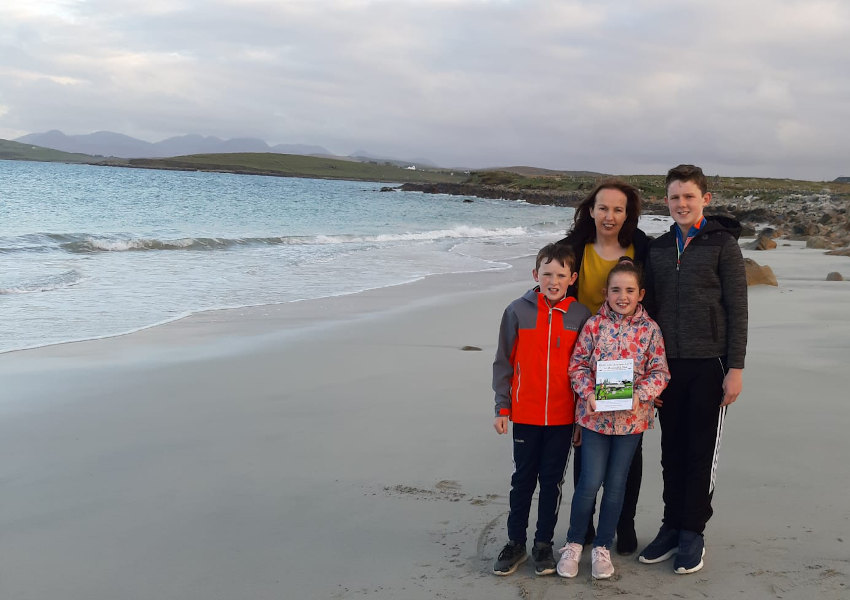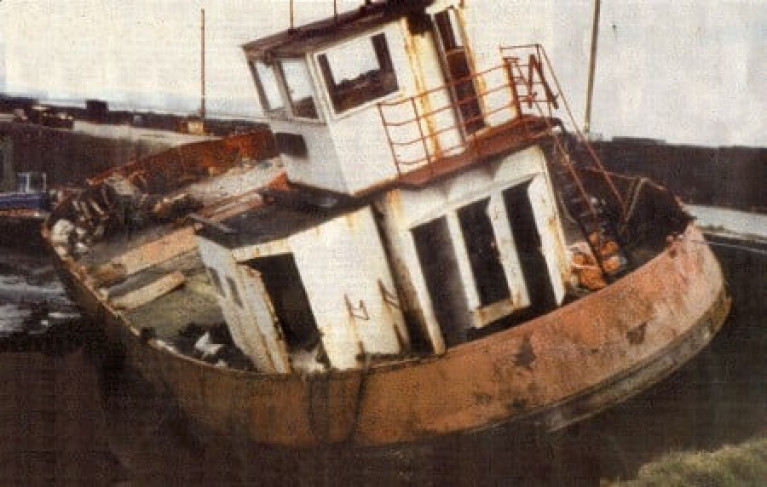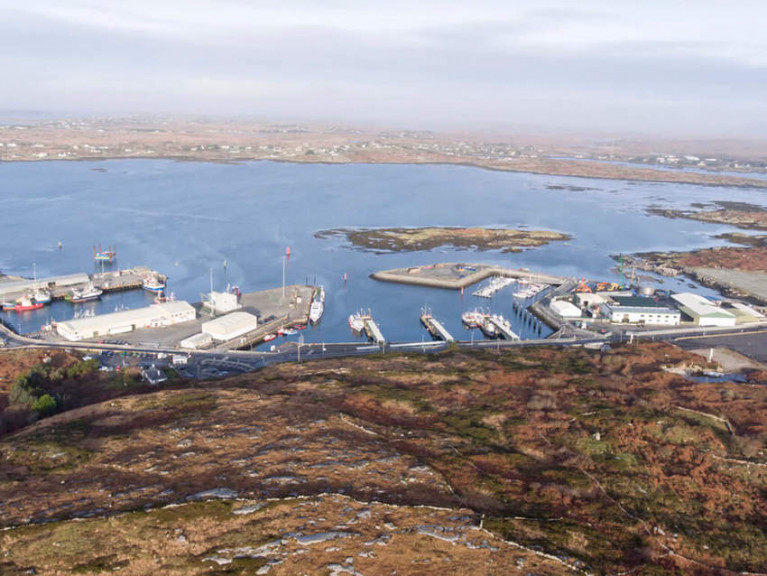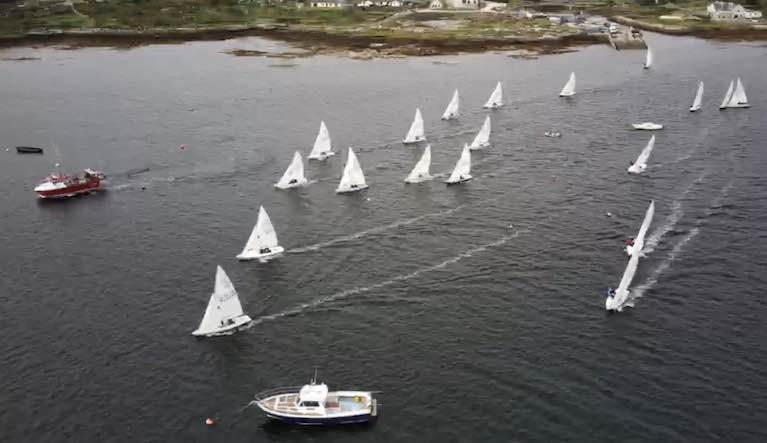Displaying items by tag: Connemara
A Connemara lobster fisherman has become a television star in the Netherlands over his role in a highly successful dating series.
As The Irish Examiner reports, Turbot island fisherman and farmer John O’Toole was hired to take a Dutch couple out fishing as part of the grand final in the highly successful dating series, Boer zoukt vrouw (“Farmer wants a wife”).
70-year-old widower Hans de Roover, who breeds horses in Noord Brabant in Netherlands, had signed up for the dating show last year. Having received replies from almost 90 applicants, he had chosen Connemara as the location for filming with one of his final four potential partners.
And 60-year old divorcee Annette Verschuure, from Zeeland, rose to the challenge. After the couple were flown to Dublin, they travelled west to Galway and Clifden, where they had been booked into the Abbeyglen Hotel.
 Farmer Hans de Roover with his new love, Annette Verschuure, at Abbeyglen Castle Hotel, Clifden
Farmer Hans de Roover with his new love, Annette Verschuure, at Abbeyglen Castle Hotel, Clifden
“So I took them out from Fahy pier down the end of the Sky Road, and a bit around the inlet as the sun was setting, ”O’Toole says. “I had set a few pots out and, of course, there were lobsters in them!”
“I asked them if they would like to handle the pots but they weren’t so keen. Annette was full of chat, and Hans had his arm around her. But then I noticed the colour draining from his face and knew it was time to head home!”
“Oh, we had such a wonderful time,” Verschuure recalls of the visit to the west of Ireland.
“It was such an adventure,” she laughs. “And because no one in Ireland knew who we were, apart from the fact that we had a film crew following us, we could actually be a couple !”
Suspense – as in who the farmer might choose for his or her partner - is key to the Dutch series, which has been running for over 12 years and now attracts some 3. 5 million viewers.
Read more in The Examiner here
If Tim Ryan could be transported back to any time in his life it would undoubtedly be the hours he spent on the ferries crossing the Severn to England and back. He did it 11 or 12 times a year with his parents and sister - and each journey was as adventurous as the last.
“It was just like going abroad,” the 67-year-old retired headteacher told WalesOnline from a quiet corner of Wales where he is hellbent on recreating those memories for future generations. It’s been a 23-year mission which is now finally beginning to bear fruit.
“My father had a sister in Burnham-on-Sea and my mother was from Wiltshire, so we were on the ferries a lot,” he said, proudly standing aboard the Severn Princess which has found its way home in remarkable circumstances.
It now sits beneath Brunel's rail bridge just metres from where it used to be moored on the River Wye from 1959 to 1966. The Princess - alongside the Severn King and Queen - offered the only means of crossing for motorists before the construction of the M48 Severn bridge.
Now we’ve got the ferry here I’d hope the long-term plan would be to get the bridge all cleaned up and maybe a visitors centre here. There’s a long way to go.”
For Tim, now coordinator of a modest team which makes up the Severn Princess Preservation Trust, it has been a labour of love long in the making. “One of our members Richard Jones is the grandson of Enoch Williams,” Tim said. “Enoch was the owner of the Old Passage Severn Ferry Company and operated the three ferries.
For much more on the former river ferry's fascinating journey to home waters, click here.
In addition, according to Wikipedia, the wrecked vessel was found full of fertiliser, having been discovered in 1999 by Dr. Richard Jones, as alluded above.
The derelict ferry had been put under a demolition order by Galway County Council, however the Severn Princess Restoration Group was set up urgently so to save and acquire the ferry for a guinea.
After repairs this enabled a five-day tow across the Irish Sea to Beachley that took place in 2003.
Conamara Mariners "Na Jimmys" Profiled on TG4
The Conamara family of sailors known as Clann Johnny Jimmy Pheaitín are profiled in a documentary on TG4.
Pádraig, Jimmy and Seáinín are “Na Jimmys”, associated with the Galway Hooker An Mhaighdean Mhara.
The programme “Bádóirí- Na Jimmys” interviews the trio and some of the other relatives well known for their knowledge of sailing and the sea on Inis Mhic Cionnaith island and An Cheathrú Rua in south Conamara.
 Pádraig, Jimmy and Seáinín are “Na Jimmys”
Pádraig, Jimmy and Seáinín are “Na Jimmys”
One relative, shipwright Pat Michael is finishing his Galway Hooker, a piece of art being built in the shed next door to home, and the Jimmys’ uncle, Johnny Jimmy, relates how he and his two brothers were the best rowers in Ireland and in England in the 1960s.
John Darba talks about Inis Mhic Cionaith, where he was raised, and the stories told by Jimmy an Oileáin, while Johnny Healion recalls when the Mhaighdean Mhara was still hauling peat to the Aran Islands, as he now prepares to launch his most newly built hooker.
 Pat agus na lads
Pat agus na lads
“Bádoirí-Na Jimmys” is on TG4, December 29th, at 8.15 pm and also available to view online here
Museum Celebrating Marconi, Jack Phillips, & Alcock & Brown Connections with Connemara Stalled Due to Lack of Ministerial Support
A Connemara business group has expressed frustration over an apparent lack of enthusiasm by Minister for Rural and Community Development Heather Humphreys in a privately funded museum that would celebrate Marconi’s connections with Connemara.
As The Times Ireland edition reports, the wireless pioneer’s historical links with Connemara, along with those of transatlantic aviators Alcock and Brown, and telegraphist Jack Phillips would be marked by the museum project.
Phillips’s selfless actions in continuing to broadcast from the ship’s wireless room saved over 700 lives during the sinking of the Titanic.
"The privately funded museum would celebrate Marconi’s connections with Connemara"
After the ship struck an iceberg in April 1912, Phillips sent “SOS” and “Come Quick Danger” (CQD) distress messages on Marconi equipment by Morse code to nearby ships until the power cut.
Clifden hotelier Brian Hughes says the museum project has enlisted the support of Sean Mulryan of Ballymore Homes who is “more than happy to fund and support this great project”.
Hughes says considerable money has already been spent on survey studies and plans by architects and engineers.
A group met Minister Humphreys and Minister of State for Transport and Galway West TD Hildegarde Naughton in November 2020, and Hughes said they formed the impression that both ministers were “fully in favour” of the project.
The business group explained that the museum could become a “jewel” on the Wild Atlantic Way, attracting up to 500,000 visitors annually and providing 40 direct and indirect jobs.
The design would also ensure that it is a “net zero carbon museum”, Hughes said.
The proposed location is at the State-owned airport site near Cleggan, which is owned by the Department of Rural and Community Development as part of its responsibility for islands.
The airport was developed to link Cleggan to Inishbofin, as part of a wider Government plan to improve air access to and from west coast islands, but the air link was never realised.
The proposed museum would focus on how Guglielmo Marconi sent and received wireless messages between his wireless station in Nova Scotia and Derrygimlagh, Connemara in October 1907.
In 1908, Marconi took on telegraphist John George “Jack” Phillips to work alongside him in Marconi station, and Phillips subsequently got a job as chief wireless telegraphist onboard the Titanic.
The museum would also mark the landing by British aviators John Alcock and Arthur Whitten Brown at Derrygimlagh on June 14th, 1919, completing the first non-stop air crossing of the Atlantic.
Hughes said the group has received positive support from Fáilte Ireland and the National Parks and Wildlife Service.
“ We are still waiting to get a letter from Ms Humphreys’s department, giving us permission to put in an application for planning permission,” he said.
The Department of Rural and Community said that “there are a number of issues arising for consideration within the department, including a proposal to construct a Coast Guard station on the site”.
“Until these issues have been fully examined, the department will not be in a position to agree to the group’s request,” it said.
Read more in The Times Ireland edition here
Loggerhead Turtle Dies in Galway After Being Blown Off Course From Canary Islands
A loggerhead turtle believed to originate from the waters around the Canary Islands has died despite the best efforts of Galway Atlantaquaria staff after it was found washed ashore in Connemara.
As RTÉ News reports, the 50kg turtle was discovered on Muighinis Beach near Carna in a comatose state and on the advice of the Irish Whale and Dolphin Group was taken to the national aquarium in Salthill.
However, Galway Atlantaquaria confirmed on social media that the adult female loggerhead turtle “never regained consciousness”.
It’s suspected that the turtle, who had been named Macdara after the patron saint of Connemara fishers, was blown off course during Storm Barra earlier this month into the colder North Atlantic.
Farmed Salmon Found in Wild Salmon River “Serious Cause for Concern” in Connemara, IFI Says
The State agency responsible for the protection of freshwater fish and habitats is investigating an incidence of farmed salmon recovered from the Connemara Fishery.
Officers from Inland Fisheries Ireland’s (IFI) Western River Basin District in Galway were alerted by anglers fishing for wild Atlantic salmon on the Dawros River in Letterfrack, more commonly known locally as the Kylemore River.
The anglers had reportedly captured fish with poorly formed fins and other distinguishing features associated with farmed salmon.
Scientists from IFI inspected various fish samples from the river and have confirmed that the fish are of “aquaculture origin” and are not wild Atlantic salmon.
The discovery is a serious cause for concern for IFI, according to its head of operations Dr Greg Forde.
“The Dawros Rivers have been designated a special area for conservation for wild Atlantic salmon and we are seriously concerned about the impact that farmed salmon could have on this native species,” he said.
“For example, farmed salmon could potentially transfer disease or could interbreed with the indigenous wild salmon population of this river.
“Salmon spawn during the month of December and each river has a genetically unique salmon stock. Early indications are that the farmed salmon, due to their size and development, could be capable of spawning this winter and interbreeding with wild fish, thereby weakening the natural genetic pool unique to the Dawros River.”
IFI says its investigations to determine the source of the escape are ongoing. The State agency has notified the Department of Agriculture, Food and the Marine, which is responsible for the issuing of aquaculture licences.
In an appeal to owners and operators of salmon fish farms around the country, Dr Forde said: “To protect and conserve wild Atlantic salmon for both current and future generations, it is absolutely essential that all salmon aquaculture installations are completely secure and farmed fish are not allowed to escape into the wild.”
Connemara Gaeltacht Harbour Could Become Hub for Marine Renewable Energy
Ros an Mhíl/Rossaveal could become a hub for marine renewable energy projects, if plans by Údarás na Gaeltachta come to fruition.
The board of the Gaeltacht authority has recently approved funding to plan the development of a 30-acre site it owns near the Connemara harbour.
Údarás na Gaeltachta says its study will include a review of the marine renewable energy sector and its potential opportunities, as well as “the requirements and advantages that Ros an Mhíl harbour and Gaeltacht companies have to meet future demands and to benefit from same”.
The organisation says renewable energy will be central to its 2021-2025 strategy, which is set for publication early next year, adding that Ros an Mhíl “has been long identified by Údarás na Gaeltachta as a strategic resource”.
Chair of the board Anna Ní Ghallachair said: “We are happy that Údarás na Gaeltachta will be in a position to undertake this study on the opportunities for renewable energy in the Ros an Mhíl area.
“This is a strategic sector for Údarás, and indeed for the whole country. If we are to halt climate change, we must avail of all opportunities there are to generate clean energy.”
Údarás na Gaeltachta hopes to issue tenders on etenders in the weeks ahead so that work can commence early in the new year.
The news comes after similar moves have been mooted for the Shannon Estuary, while in Cork a new strategic partnership aims to improve communication with the wider marine community as the pace of offshore wind farm development picks up.
Launch of New Irish Children’s Book on Connemara is a Boost to Clifden Lifeboat Team
A new children’s book focusing on the local history and mythology of the North West Connemara region has been launched this week in Co Galway.
And a portion of the proceeds is being donated to the Clifden RNLI lifeboats for their dedication to saving lives at sea.
Local author and youth worker Marie Feeney has produced From Our Ancient Land to Bountiful Sea, an informative and often humorous collection of local history and folklore tales with illustrations by Gary Kendellen.
These tales include accounts of the famous engineer Alexander Nimmo, who designed many piers and bridges in the Connemara area, and a blend of local history and myths that will appeal to locals and visitors alike.
Marie’s first book The Cleggan Disaster comprehensively and poignantly detailed the tragic drowning of 45 men from the fishing communities of Cleggan, Claddaghduff and Inishbofin and the Inishkeas, and also benefitted the local RNLI lifeboats.
 Author Marie Feeney with her children Ronan, Diarmuid and Michaela at Sallerna Beach in Cleggan, Co Galway | Photo: Marie Feeney
Author Marie Feeney with her children Ronan, Diarmuid and Michaela at Sallerna Beach in Cleggan, Co Galway | Photo: Marie Feeney
On the launch of her new book, Marie said: “The coastline of Connemara, while exceptionally beautiful is also treacherous and mostly utilised by people who use it either for pleasure or their livelihood.
“Thankfully in our community, we have a dedicated RNLI volunteer team who provide an invaluable service by saving lives each year, sometimes in the most challenging environments.
“The philosophy of the RNLI is astounding. The purpose to save lives, their vision to save everyone, their volunteer ethos, their charitable and community base. Every life matters, and of course their maritime expertise is crucial.”
From Our Ancient Land to Bountiful Sea is now on sale locally in Connemara at The Clifden Bookshop, Letterfrack Country Shop, Gala Cleggan and Sweeney’s Claddaghduff. The book is also available online at the inConnemara Bookshop.
Airstrip is the Answer for Homeless Cleggan Coast Guard, Says TD
Cleggan Coast Guard in Connemara is long overdue a permanent base — and a local TD insists the village’s airstrip is the answer.
As the Connacht Tribune reports, Éamon Ó Cuív says it is unacceptable that the coastguard service for north Connemara has been seeking a fixed abode for so long.
A number of sites are being considered by the OPW — but Deputy Ó Cuív says none would be more suitable than the State-owned Cleggan Airstrip.
The Connacht Tribune has more on the story HERE.
Connemara Flying Fifteens Hold Last League Race of Summer 2020
With a nice southerly breeze, 19 Flying Fifteens hoisted their sails early morning for the last race of the Connemara league.
As Afloat reported previously, a rejuvenated fleet in County Galway is boasting one of the largest fleets in the country with up to 27 actively club racing.
The course laid meant plenty of tacking down the bay rounding the cannon rock buoy and head for the finish line in the next neighbouring bay Cuan an fhir Mmhór where the finish line was in front of Caladh Thaidhg pier.
With good upwind sailing out of Casla Bay came a split in the fleet with the western side of the bay paying off. Leading at the Mark was Ronán O Briain (Ffingers crossed IRL 3588) closely followed by his cousin Niall O'Brien (Mind over Matter IRL 275) in third was Martin Griffin (Havoc IRL 3145). Next came the leader of the eastern boats, Christopher Griffin (Fraoch Geal IRL 3383) a couple of boat lengths behind.
With the wind freshening and spinnakers flying the reach to Caladh Thaidhg was swift. There was no change at the top of the leaderboard as they crossed the line in front of several spectators gathered along the shore.
Race 1 results top 6
- Ronán O'Briain (Fingers crossed IRL 3588)
- Niall O'Brien (Mind over matter IRL3275)
- Martin Griffin (Havoc IRL 3145)
- Christopher Griffin (Fraoch Geal IRL 3383)
- Cian&liam O'Conghaile (user-friendly IRL 3397)
- Micheál O'Conghaile (Stork GBR 3403)
The boats gathered again, and the second race was ready for the off for the return journey home. Niall o Brien got off to a great start and was leading at the mouth of the bay, followed closely by Martin Griffen, Ronan o Briain and Clíona ní Bhriain (Simply red IRL 3203) once past the turning mark at cannon rock the spinnakers started to go up, and the standings changed.
Race 2 results top 6
- Ronán O'Brien (Fingers crossed IRL3588)
- Niall O'Brien (Mind over matter IRL 3275)
- Micheál O'Conghaile (Stork GBR 3403)
- Martin Griffin ( Havoc IRL 3145)
- Cian & Liam O Conghaile (User-friendly IRL 3397)
- Cliona O'Brien (Simply Red IRL 3203)
The league results and prizes were given on the pier afterwards.
With the 2020 league top six finishers as follows:
Overall winner 2020
- Niall o Brien (Mind over matter IRL 3275)
- Cian & Liam o Conghaile (User-friendly IRL 3397)
- Martin Flaherty (The Real thing IRL 3108)
- Martin Griffin. (Havoc IRL 3145)
- Ronán o Brien (Fingers crossed IRL 3588)
- Cliona o Brien (Simply Red IRL 3203 )


































































